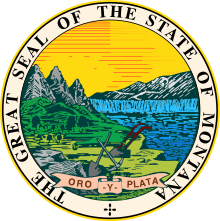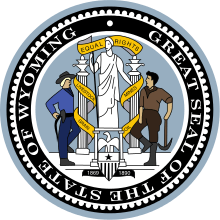Truman C. Everts
Truman C. Everts (1816 – February 16, 1901) was the first federal tax assessor for the Montana Territory and a member of the 1870 Washburn–Langford–Doane Expedition, which explored the area which later became Yellowstone National Park. He became lost in the wilderness for 37 days during the expedition and a year later became more widely known after writing about his ordeal for Scribner’s Monthly.[1]
Truman C. Everts | |
|---|---|
Photo of Everts published in The Discovery of Yellowstone Park (1870) | |
| Born | 1816 |
| Died | February 16, 1901 (aged 84–85) |
| Occupation | Assessor of Internal Revenue for the Montana Territory (1864–1870) U.S. Post Office in Maryland |
| Known for | Washburn-Langford-Doane Expedition |
History
Everts was one of six brothers born in Burlington, Vermont to a Great Lakes ship captain.[2] During the American Civil War, President Abraham Lincoln appointed Everts the first Assessor of Internal Revenue for the newly created Montana Territory, a position he held between July 15, 1864 and February 16, 1870.[2]
"Thirty-Seven Days of Peril"
In 1870, President Ulysses S. Grant's administration replaced Everts in his role as tax assessor. After months of unemployment in the frontier territory, Everts took the opportunity to accompany an expedition led by Henry D. Washburn and Nathaniel P. Langford into the still largely unexplored wilderness that would later become Yellowstone National Park. The Washburn–Langford–Doane Expedition of 1870 was the second official survey of the Yellowstone region in less than two years.
After falling behind the rest of the expedition on September 9, 1870, Everts managed to lose the pack horse which was carrying most of his supplies. Without food or equipment, he attempted to retrace the expedition's route along the southern shore of Yellowstone Lake in the hopes of finding his companions. He ate a songbird and minnows raw, and a local thistle plant to stay alive; the plant (Cirsium foliosum, commonly known as elk thistle) was later renamed "Evert's Thistle" after him.[1][3] As well as the lack of food, Everts faced the coming autumn weather, including early snowstorms, and at one point was stalked by a mountain lion.
Everts' party searched for him for more than a week, setting signal fires, firing guns into the air, and leaving notes and caches of supplies for Everts along the lake. Though a site near the lake had earlier been designated as a meeting point in case one of the party members became lost, Everts, for unknown reasons, never showed. The expedition returned to Fort Ellis by early October. His friends in Helena offered a reward of $600 to find his remains.[4]
On October 16, more than a month after his separation from the group, two local mountain men – "Yellowstone Jack" Baronett and George A. Pritchett – found Everts, suffering from frostbite, burn wounds from thermal vents and his campfire, and other injuries suffered during his ordeal, so malnourished he weighed only 50 pounds (23 kg).[4] Baronett and Pritchett were part of a search party which had been sent from Montana to find Everts' remains. They discovered him, mumbling and delirious, more than 50 miles (80 km) from where he had first become lost.[4] One man stayed with Everts to nurse him back to health while the other walked 75 miles (121 km) for help.
Everts' rescuers brought him to Bozeman, where he recovered. The next year, Everts' personal account of the experience, "Thirty-Seven Days of Peril", was published in Scribner’s Monthly.[5] The story of his survival became national news and contributed a great deal of publicity to the movement to preserve the Yellowstone area as the country's first national park.[2] In spite of their assistance, Everts denied Baronett and Pritchett payment of the reward, claiming he could have made it out of the mountains on his own.[2][6]
Henry D. Washburn named a peak near Mammoth Hot Springs "Mount Everts" shortly after Everts' rescue. During the expedition, Washburn had named a peak in the Thorofare region south of Yellowstone Lake for Everts but later changed it to the current peak, believing it to be near the location of the rescue. In fact Everts was rescued much farther north, near Blacktail Deer Creek.[7]
Later years
After the two expeditions and the fame from his article, Everts was offered the position of first superintendent of the newly established Yellowstone National Park, but he declined since it did not include a salary. He later moved to Hyattsville, Maryland and worked in the U.S. Post Office. He died there in 1901,[2] in his home, of pneumonia.[4]
References
- "National Parks: America's Best Idea". Public Broadcasting System. 2009. Retrieved 2009-09-28.
- "Yellowstone National Park: Its Exploration and Establishment Biographical Appendix". National Park Service. July 4, 2000. Retrieved 2009-09-28.
- "Evert's or Elk Thistle". USDA Forest Service: Idaho Panhandle National Forests.
- Ferry, David (August 23, 2016). "The Hapless Explorer Who Helped Create the National Park System". Outside.
- Everts, Truman C. (November 1871). "Thirty-Seven Days of Peril". Scribner's Monthly. Cornell University Library website. III (1): 1–17. Retrieved 2009-09-28.
- Smith, Phyllis (1996). Bozeman and the Gallatin Valley: A History. Globe Pequot. pp. 115–117. ISBN 978-1-56044-540-1. Retrieved 2009-09-27.
- Haines, Aubrey L. (July 1972). "Lost in the Wilderness-Truman Everts' 37 Days of Terror". Montana The Magazine of Western History. Helena, MT: Montana Historical Society. XXII (3): 31–41.
External links
- Works by Truman C. Everts at Project Gutenberg
- Works by or about Truman C. Everts at Internet Archive
- Works by Truman C. Everts at LibriVox (public domain audiobooks)


